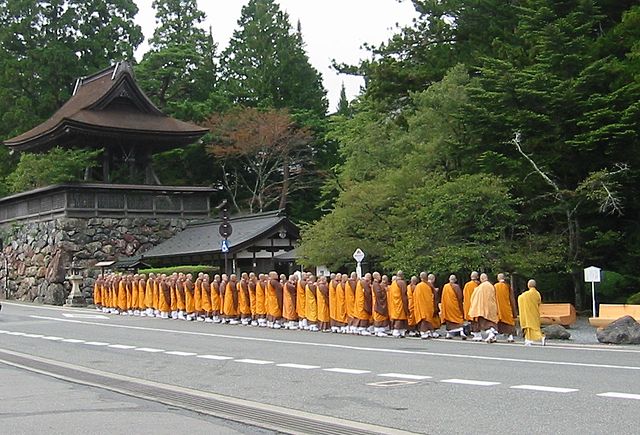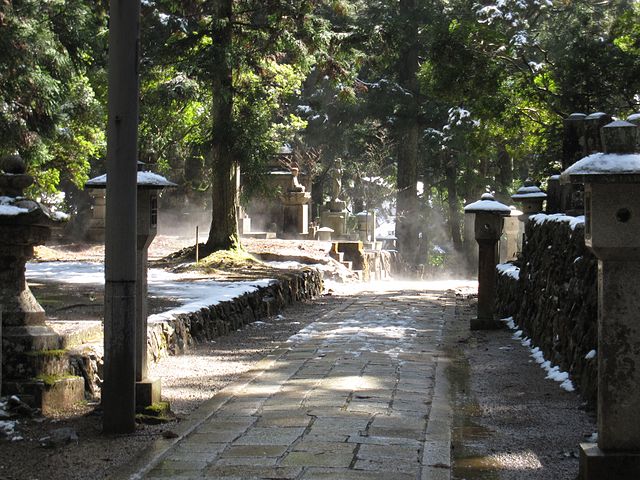The wonders of Koyasan’s Buddhist spiritual worlds nextdoor to Osaka

Koyasan or Koya-san is Japan's most famous Buddhist spiritual center for international tourists and for good reason. It is not a place where you have to change your religious beliefs, nor are you forced to do spiritual practices against your will. Koyasan is really about a unique experience similar to say Lhasa in Tibet or the Vatican (in a way!).
I recommend sleeping one night in Koyasan but it can also be a day trip from Kyoto or Osaka.
In the early part of the ninth century, Kukai (also known as Kobo Daishi, "The Great Teacher of the Vast Dharma") was given permission to start a religious center for the propagation of the Buddhist Mahayana and Vajrayana teachings which he had acquired while studying in China for seven intense years. This center on Mt. Koya, however, was located far from the capital, Heian-kyo (Kyoto), but eventually became the headquarters of the Shingon ("True Word") school of Japanese Buddhism, which is also called Japan's Imperial Buddhism.
Compared to the other, more accessible schools of Buddhism, Shingon Buddhism with its mantras, mudras (a non-verbal mode of communication and self-expression, consisting of hand gestures and finger- postures), and mandalas (sand drawings that take forever the way enlightenment takes forever) was deemed an "esoteric" way to Nirvana or enlightenment. Its practices were not for everyone and certainly its location in the high mountains of present-day Wakayama Prefecture, southeast of Osaka, confirmed its emphasis on the priority of retreating from the world and performing religious austerities far from the madding crowd.
The enormity of Kukai's project to build a religious center on Mt. Koya can still be felt today as you ride the train and then the cable car up the steep mountainsides to the small town of Koya. It's one thing to hop on a train and go look at the fruit of Kukai's labors; it must have been quite another to have been the initiator of such an effort more than 1,200 years ago.
For both the short-term and long-term visitor to the Kyoto area, though, an overnight trip to Mt. Koya is to be savored. As a religious center, it attracts a huge number of Japanese pilgrims. Many come here as the first stop on their pilgrimage to the eighty-eight temples on Shikoku, a pilgrimage attributed to Kukai himself. Other Japanese people and monks from distant lands come to Koyasan to pay their respects to Kukai's tomb or perhaps take part in religious services at some of the fifty-three temples that accommodate visitors.
For the foreign tourist as well, with or without any spoken Japanese ability, this is a trip that can be made with relative ease. Ideally, an overnight stay at one of the temples with a vegetarian dinner and breakfast included is the best way to experience some of the religious atmosphere of Kyoya. For those on a tight schedule, however, it is possible to make the trip in a day. From Kyoto, take the limited express (tokkyu) Keihan or Hankyu trains to either Yodoyabashi or Umeda respectively. At either of these stations you can get the Midosuji subway line to Namba. Once you're in Namba, go to the Nankai Railway Line and get tickets for super-fast Koyasan trains (4 per day). To make the trip up and back in a day from Kyoto, you have to take either the 9:20 or the 9:50 fast train from Nankai Railways, Namba.
Content by Ian Martin Ropke, owner of Your Japan Private Tours (est. 1990). I have been planning, designing, and making custom Japan private tours on all five Japanese islands since the early 1990s. I work closely with Japan private tour clients and have worked for all kinds of families, companies, and individuals since 1990. Clients find me mostly via organic search, and I advertise my custom Japan private tours & travel services on www.japan-guide.com, which has the best all-Japan English content & maps in Japan! If you are going to Japan and you understand the advantages of private travel, consider my services for your next trip. And thank you for reading my content. I, Ian Martin Ropke (unique on Google Search), am also a serious nonfiction and fiction writer, a startup founder (NexussPlus.com), and a spiritual wood sculptor. Learn more!

If you're planning to stay overnight, you can also get the 13:15 or the 14:15 train and still be there in time for an amazing mystery stroll through Koyasan's vast and Instagram-famous Okunoin cemetery to Kukai's tomb. The cemetery stroll, if timed right, can lead to incredible dust mote moments, as the dust is caught in the last rays of sun slanting through the cemetery's forest. Later at night, after dinner, if you pay special attention, you can see and certainly hear Japan's huge musasabi flying squirrels in the Okunoin cemetery. Sometimes, they drop pine cones on people for fun!
The best-known higher-priced temple accommodation places in Koyasan are: Rengejo-in, Haryo-in, Fukuchi-in, Tentoku-in, Fudo-in and Shojoshin-in (which is a 2-min walk from the Okunoin cemetery entrance). To make reservations before you go, visit the Koya-san Tourist Association website: https://eng-shukubo.net/shukubo/ .
Expect to pay Yen 15,000 and up for one night in Koyasan per person but remember this also includes two banquet-style Buddhist monk vegetarian cuisine. Meals are served in very elegant rooms on red trays with sake, beer or juice. After dinner, you can take a bath in the temple's private wooden ofuro bath and then relax with some more beer or sake till you pass out on the thickest futons you'll ever see in Japan.
In the morning there is a bell at about five-thirty signaling the start of morning services at six. Anybody staying at the temple can attend these services and even though it is a bit cold in the winter (despite the hot carpet on which visitors get to sit), the early morning chanting is extraordinarily beautiful. Visitors are also invited to offer incense to a small Buddhist shrine during the service.
Koyasan is "the" place in Japan for top quality Japanese incense and also a wide range of Shingon Buddist accessories (rosary beads, vjaras (five-pronged ritual object extensively employed in esoteric Vajrayāna school of Buddhism), porcelain vessels.
For the visitor to Japan who wants to look more deeply into the heart of a Buddhist practice and pilgrimage center, it would be difficult to find anyplace more fitting than Mt. Koya. On the other hand, if you just want to get out of the city, breathe some truly clean air, and see some magnificent scenery, you won't be disappointed here either. But if Koyasan is just too far or too expensive then you can also have a similar experience almost in Kyoto in the vast high-mountain worlds of Enryakuji Temple on Mount Hiei (prominently guarding Kyoto's northeastern corner).
- Modern Japanese society & insights
- Japanese history & key shoguns, dynasties and stories
- Shinto in daily Japanese life
- Buddhism in daily Japanese life
- Japanese handicrafts: overview, types, shopping tips
- Tea ceremony overview
- Japanese gardens: overview and interesting facts
Content by Ian Martin Ropke, owner of Your Japan Private Tours (est. 1990). I have been planning, designing, and making custom Japan private tours on all five Japanese islands since the early 1990s. I work closely with Japan private tour clients and have worked for all kinds of families, companies, and individuals since 1990. Clients find me mostly via organic search, and I advertise my custom Japan private tours & travel services on www.japan-guide.com, which has the best all-Japan English content & maps in Japan! If you are going to Japan and you understand the advantages of private travel, consider my services for your next trip. And thank you for reading my content. I, Ian Martin Ropke (unique on Google Search), am also a serious nonfiction and fiction writer, a startup founder (NexussPlus.com), and a spiritual wood sculptor. Learn more!